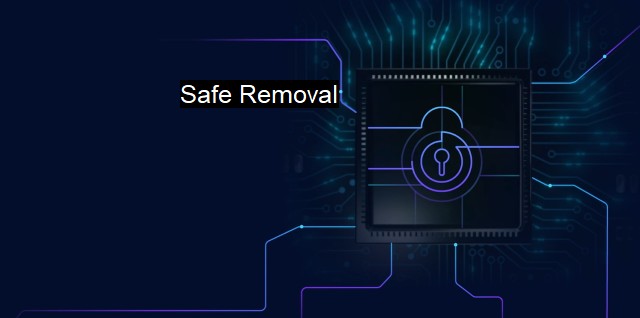What is Safe Removal?
Understanding Safe Removal: A Critical Step in Cybersecurity and Antivirus Software Maintenance
Safe removal refers to a secure methodology used to eject or disconnect an external device from a computer system. It is critical for maintaining the integrity and safety of data contained in external devices like memory cards, hard drives, and USB drives, which are often used interchangeably on different systems. Safe removal is more than simply removing an external storage device. From a cybersecurity perspective, it safeguards sensitive data from unauthorized access, corruption, and loss while also preventing potential cybersecurity threats like viruses, malware, and ransomware.Safe Removal can be considered a basic but crucial aspect of cybersecurity etiquette. Every time an external device is carelessly ejected out of a system, it not only puts the data integrity at risk but also leaves an open gate for potential cyber threats. Non-procedural disconnection can lead to loss or corruption of data, hence leading to additional susceptibility to different security risks. Therefore, acknowledging the importance of safe removal is paramount for data integrity and cybersecurity.
When a device is connected to a computer system, the system starts communicating with it to facilitate data transfer processes. During this process, the system might be engaged in writing important data onto the device. Improper removal of the device during such write operations could lead to corruption of important data files, rendering them unreadable and useless. The corrupted files might also serve as hosts for various types of malware which can infiltrate the system once the device is plugged in again. Thus, from a cybersecurity standpoint, safe removal ensures that all ongoing processes are completed properly before the device's connection to the system is terminated.
In the context of antivirus software, safe removal is a critical factor that aids in maintaining system integrity and data security. Antivirus software scans external devices that are plugged into a system for any potential threats, harmful files, or suspicious activities. An abrupt or incorrect removal of the device might lead to an incomplete scanning process, hence potentially missing out on detecting cyber threats that may be present in the device. Therefore, safe removal helps in ensuring that the antivirus software has enough time to perform a complete scan of the device, identifying and eliminating threats, if any.
Just like the numerous practices or measures that constitute a comprehensive cybersecurity policy, safe removal is not to be taken for granted. The integration of safe removal protocols within the technical procedures can contribute greatly to strengthening cybersecurity. Everyone, from individuals to organizations, needs to incorporate safe removal procedures when handling external storage devices and not overlook its importance.
As our dependency on these external devices continues to rise in both personal and professional realms, and as threat actors continue to leverage various attack vectors, the need for additional layers of protection and precaution becomes evident. And safe removal, though often overlooked, serves crucial functions toward ensuring that data is protected and securing interconnected systems against potential cybersecurity risks.
Safe removal pervades multiple layers of data protection and cybersecurity strategies. While it is a basic operation that determines the integrity of our data and safety of our systems, not adhering to it opens an unnecessary window of vulnerability that can compromise data and cybersecurity. Safe removal aligns with healthy cybersecurity hygiene practices, promoting safer environments for data management and exchange.

Safe Removal FAQs
What is safe removal in cybersecurity?
Safe removal in cybersecurity refers to the proper and secure removal of software, files or data to prevent any potential harm to your computer system.Why is safe removal important?
Safe removal is important because incomplete or improper removal of software or files can leave behind remnants that can cause system instability, security vulnerabilities, or even malware infections.What are the best practices for safe removal in antivirus?
The best practices for safe removal in antivirus include closing all associated programs before uninstalling, using the built-in uninstaller, using the latest version of the antivirus software, and running a full system scan after the removal process to ensure all remnants are removed.What are the consequences of unsafe removal in cybersecurity?
Unsafe removal in cybersecurity can lead to system instability, security vulnerabilities, and malware infections. It can also cause corrupted files, data loss, and performance issues. Ultimately, unsafe removal can compromise the security and overall functionality of your computer system.| | A | | | B | | | C | | | D | | | E | | | F | | | G | | | H | | | I | | | J | | | K | | | L | | | M | |
| | N | | | O | | | P | | | Q | | | R | | | S | | | T | | | U | | | V | | | W | | | X | | | Y | | | Z | |
| | 1 | | | 2 | | | 3 | | | 4 | | | 7 | | | 8 | | |||||||